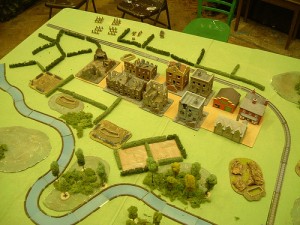And when I say rough, I mean rough. There are a huge number of company and acquisition dramas in the relatively short history of the tabletop rpg, but it’s something that I can’t go too in depth on, for brevity’s sake. If you think this little bit of background is cool, I definitely suggest checking out the Evil Hat “Designers and Dragons” history series, as well as “Playing at the World” by Jon Peterson. One could argue that tabletop games go back as far as anybody’s been playing chess, but that’s another, much more theoretical argument that we don’t need to get into right now. The first commercial tabletop roleplaying game is accredited to TSR’s Dungeons and Dragons, and that’s going to be our grounding point.

In the 50s, we had wargames taking hold (and I should note, this was a small niche community, almost entirely built of white men who could afford to play). These were played on tabletop, but used miniatures to represent armies, and were solely played to simulate actual armies and battles. Some people started wanting to get a more personal interaction with their armies, which resulted in games where players would take control of individual units like spies or guards, and play through small scenarios. At the same time, some people wanted to break out of the traditional wargaming tropes, they wanted to try fantasy scenarios. These sorts of ideas built up and coalesced into Dave Arneson and Gary Gygax’s Dungeons and Dragons fantasy roleplaying game. This niche of a niche had trouble finding a foothold at first, but soon vastly outgrew its expectations.

Over several years it inspired many other games, all centered around having individual adventurers playing through a story in an ahistorical setting. Most of the settings were richly developed fantasy or science fiction worlds, though there was also some interest in other worlds like spies, superheroes, or horror. It was a completely new field, and there were a lot of people excited to plow it.
Then, in the 80s, a huge moral panic sprang up around these games, though most of it was specifically directed at D&D. Nowadays, if a kid strikes out in violence, the media blames it on his Xbox. Back then, it would be blamed on D&D. Many religious groups were worried that it was actually teaching children magic, or that it would cause them to be unable to distinguish the difference between fantasy and reality (not helped by Tom Hank’s portrayal of an out of touch gamer in Mazes and Monsters). This and several other factors caused a massive deflation in the tabletop rpg market by the late 80s.
Since then, tabletop rpgs have come back in a big way. With the dawn of online publishing, it became much easier for smaller, independent companies to produce for their audience. So what does that all have to do with sociology? Well, I always think it’s good to make sure everybody has the same base knowledge of something, since that makes it easier to talk about. But it also has the benefit of giving some background to some of the statistics I’m about to throw your way, and some of the seeds for the conversation’s we’ll be having later. Demographics are important to talking about social structures within a subculture, and data is a good way to learn about demographics.
In 2013 this study got released. Its a collection of sales data from almost 300 companies, and it looks like things are going well in the industry. There’s huge amounts of growth and stability in that data, as well as some interesting developments in game designers’ plans. The online market continues to be one perfectly suited for tabletop games, allowing a niche product to reach the largest quantity of people. Kickstarter has become the new go to launching platform for all but the most big name companies. This has worked incredibly well in some cases, though some older companies have had trouble adapting to the new resource.
Information on gamers themselves is a little harder to come about. Most of the more professionally collected data is old, and anything else has unreliably small sample sizes. There’s a collection of some of this here, and while it’s always best to take this data with a grain of salt, it does evidence something a lot of people are thinking; that gaming is a man’s world. Now, in video games that isn’t as strongly the case any more. Women are overtaking some of video gaming’s male demographic pie, we have much more recent data on that. And while hopefully similar things are happening in tabletop games, I wouldn’t be surprised if the recent change isn’t near so drastic. Tabletop communities can easily become insular (that’s another topic for another day) in a way videogames, given their easier point of access, don’t.
So there’s some history and some numbers to get you started, but there’s plenty more places to look! If you have any interesting historical tidbits, feel free to share them in the comments below.